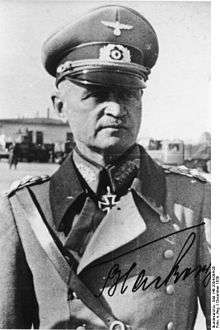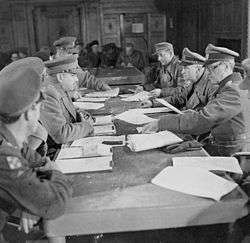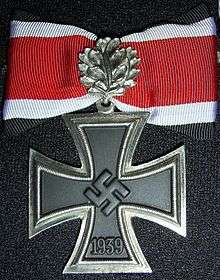Johannes Blaskowitz
| Johannes Albrecht Blaskowitz | |
|---|---|
 Johannes Blaskowitz | |
| Birth name | Johannes Albrecht Blaskowitz |
| Born |
10 July 1883 Paterswalde, Province of East Prussia, Kingdom of Prussia, German Empire now Bolshaya Polyana, Kaliningrad Oblast, Russian Federation |
| Died |
5 February 1948 (aged 64) Nuremberg, Bavaria, Allied-occupied Germany |
| Allegiance |
|
| Service/branch | Wehrmacht |
| Years of service | 1901–45 |
| Rank | Generaloberst |
| Commands held |
8. Armee 9. Armee 1. Armee Heeresgruppe G Heeresgruppe H |
| Battles/wars |
World War I World War II |
| Awards | Knight's Cross of the Iron Cross with Oak Leaves and Swords |
Johannes Albrecht Blaskowitz (10 July 1883 – 5 February 1948) was a German general during World War II and recipient of the Knight's Cross of the Iron Cross with Oak Leaves and Swords.
Commander in Chief in the Occupied Poland in 1939–1940, he had written several memoranda for the German High Command protesting the SS atrocities. He was dismissed, but then re-appointed, no longer calling Nazi policies into question. Charged with war crimes in the High Command Trial at Nuremberg, he committed suicide on 5 February 1948.[1] Both the indictment and the suicide have been considered an enigma by scholars ever since, because he was later acquitted on all counts and had been told to expect to be acquitted by his defense. [2][3][4]
Early years
Johannes Blaskowitz was born on 10 July 1883 in the village of Paterswalde, (East Prussia), Germany (now Bolshaya Polyana in the Kaliningrad Oblast, Russia). He was the son of a Protestant pastor, Hermann Blaskowitz, and his wife Marie Blaskowitz, née Kuhn. In 1894, Blaskowitz joined cadet school at Köslin (now Koszalin, Poland) and afterwards at Berlin Lichterfelde. In 1901, he started his military career as an officer candidate cadet in an East Prussian regiment in Osterode (Polish: Ostróda).
World War I
During World War I, Blaskowitz served on the Eastern and Western Fronts and was employed in the General Staff. He rose to command an infantry company by 1918, and was awarded the Iron Cross for bravery.
Interwar period
Blaskowitz's war service secured him a place in the small postwar Reichswehr during the Weimar Republic, through whose ranks he rose to the rank of General. His attitude towards the Nazis' seizure of power in 1933 was reportedly indifferent because he believed that the armed forces should be "politically neutral".
In early 1939 he commanded the German forces that occupied Austria and Czechoslovakia, and was promoted to General of Infantry and given command of the 8th Army just prior to the outbreak of World War II
During the Invasion of Poland that began World War II, the 8th Army under Blaskowitz's command participated in the Battle of the Bzura. He commanded the army as it besieged Warsaw. After the campaign, he was awarded the Knight's Cross of the Iron Cross (Ritterkreuz des Eisernen Kreuzes), promoted to Colonel-General and appointed as Commander-in-Chief East in Poland on 20 October 1939.
Poland 1939
As a traditional soldier, Blaskowitz kept a firm control on the men under his command in their dealings with civilians and was opposed to Army participation in war crimes by the SS and Einsatzgruppen. Between November 1939 and February 1940 he wrote several memoranda to higher military officials, in which he detailed SS atrocities in Poland, their negative effects on Wehrmacht soldiers and the insolent attitude of the SS toward the army. However, his protests failed to produce results, and merely earned him the enmity of Hitler, Hans Frank, Reinhard Heydrich and Heinrich Himmler, while Chief of Staff Alfred Jodl dismissed them as naive and "uncalled for".[5][6]
Commander-in-Chief Walther von Brauchitsch forwarded Blaskowitz's first memorandum to Hitler on 18 November, who launched a tirade against Blaskowitz, denouncing his concerns about due process as "childish" and poured scorn on his "Salvation Army attitude."[7] Blaskowitz was relieved of his command on 29 May 1940.[8]
Occupation of France
Following the Fall of France in May 1940, Blaskowitz was initially slated to command the 9th Army for occupation duties, but the appointment was blocked by Hitler and instead he was appointed to a relatively minor position as Military Governor of Northern France, a position he held until October 1940, when he was transferred to the command of the 1st Army, on the southwest coast between Brittany and the Spanish border.[1]
In May 1944, following the appointment of Gerd von Rundstedt as Commander-in-Chief in the West, Blaskowitz was appointed head of Army Group G.[9] This comparatively small command, consisting of the 1st Army and the 19th Army, was given the task of defending southern France from the imminent Allied invasion. When in Normandy, he managed to convince Field Marshal Erwin Rommel that the "rumours" Rommel had heard about atrocities on the Eastern Front were actually true. [10]
The invasion of southern France commenced on 15 August 1944, with Operation Dragoon, when Allied forces landed on the Riviera between Toulon and Cannes. Blaskowitz, though badly outnumbered and lacking air defense, brought up troops, stabilized the front, and led a fighting withdrawal to the north to avoid encirclement. U.S. Army units pursued Blaskowitz's forces up through the Vosges mountains before pausing to regroup and refuel. There, Blaskowitz's troops were reinforced by the 5th Panzer Army under Hasso von Manteuffel. Blaskowitz wanted to entrench his forces, but Hitler ordered him to immediately counterattack the U.S. Third Army. Both Manteuffel and Blaskowitz realized the futility of such an action, but obeyed orders, and their attack caught U.S. forces in disarray and pushed them back to near Lunéville on 18–20 September 1944, at which point resistance stiffened and the attack was suspended. As a result, Hitler summarily relieved Blaskowitz, replacing him with Hermann Balck.[9]
Campaign in the West 1944–45
In December 1944, Blaskowitz was recalled to his previous command and ordered to attack in the vicinity of Alsace-Lorraine in support of the ongoing Ardennes offensive. On 1 January 1945 Army Group G engaged the U.S. 7th Army during Operation Nordwind, forcing them to withdraw.[9]

Blaskowitz was subsequently transferred to Holland, where he succeeded Kurt Student as commander of Army Group H. For the following three months he conducted a fighting withdrawal against the British 2nd Army, being awarded the Swords to his Knight's Cross. This command was redesignated in early April 1945 and Blaskowitz became commander-in-chief of the northern (still occupied) part of the Netherlands. From 29 April, Blaskowitz allowed Allied airdrops of food and medicine to the Dutch civilian population in operations Manna and Chowhound.[11]
On 5 May Blaskowitz was summoned to the Hotel de Wereld in Wageningen by General Charles Foulkes, (commander of I Canadian Corps), to discuss the surrender of the German forces in the Netherlands. Prince Bernhard, acting as commander-in-chief of the Dutch Interior Forces, attended the meeting.[12] Blaskowitz agreed with all proposals by Foulkes. However, nowhere in the building – some sources say nowhere in the whole town – could a typewriter be found. Thus, the surrender document could not be typed. The next day, both parties returned and, in the presence of both Foulkes and Prince Bernhard, Blaskowitz signed the surrender document, which in the meantime had been typed. [13]
Postwar
Blaskowitz was charged with war crimes during the Nuremberg Trials in the High Command Trial (Case No. XII). He committed suicide on 5 February 1948: after breaking away from his guards, he threw himself off a balcony into the inner courtyard of the court building.[1]
Decorations
- Iron Cross (1914)
- Clasp to the Iron Cross (1939)
- German Cross in Silver on 30 October 1943 as Generaloberst and commander-in-chief of the 1. Armee[15]
- Knight's Cross of the Iron Cross with Oak Leaves and Swords
- Knight's Cross on 30 September 1939 and General der Infanterie and commander-in-chief of the 8. Armee[16][17][18]
- 640th Oak Leaves on 29 October 1944 as Generaloberst and commander-in-chief of the Heeresgruppe G[16][19][20]
- 146th Swords on 25 April 1945 as Generaloberst and commander-in-chief of the Netherlands[16][21][22]
- Anschluss Medal (1938)
- Sudetenland Medal (1938) with Prague Castle bar (1938)
- Wound Badge- 1918 type (?)
- Honour Cross of the World War 1914/1918 (1934)
- Bavarian Military Merit Cross 3rd Class with Swords (1916)
- Prussian Knight's Cross of the Royal House Order of Hohenzollern with Swords (1917)
- Baden Knight's Cross 2nd Class of the Order of the Zähringer Lion with Swords(1915)
- Oldenburg Friedrich August Cross Second (1916) and First (1916) Classes
- War Merit Cross Second (?) and First (?) Classes
- Order of the Crown of Italy, Grand Cross (1941)
- Mentioned in the Wehrmachtbericht (27 September 1939)
References
Citations
- 1 2 3 Fest 1997, p. 380.
- ↑ Zabecki, David T. (2014). Germany at War: 400 Years of Military History [4 volumes]: 400 Years of Military History. ABC-CLIO. p. 42. ISBN 9781598849813.
- ↑ Baratieri, Daniela; Edele, Mark; Finaldi, Giuseppe (Oct 8, 2013). Perspectives on the Nuremberg Trial. Routledge. p. 57. ISBN 9781135043971.
- ↑ Mettraux, Guénaël (2008). The Nuremberg Military Tribunals and the Origins of International Criminal Law. Oxford University Press. p. 475. ISBN 9780199232338.
- ↑ Kane 2002, p. 161.
- ↑ Fredriksen, John C. (2001). America's Military Adversaries: From Colonial Times to the Present. ABC-CLIO. pp. 57–58. ISBN 9781576076033.
- ↑ Kitchen 2008, p. 247.
- ↑ Rabinbach, Anson; Gilman, Sander L. (Jul 10, 2013). The Third Reich Sourcebook. University of California Press. p. 722. ISBN 9780520955141.
- 1 2 3 Fredriksen 2001, p. 58.
- ↑ Giziowski, Richard John (1997). The enigma of General Blaskowitz. Leo Cooper. p. 262. ISBN 9780781805032.
- ↑ Fredriksen 2001, p. 59.
- ↑ Goddard, Lance (May 1, 2005). Canada and the Liberation of the Netherlands, May 1945. Dundurn. ISBN 9781459712539.
- ↑ http://www.dfait-maeci.gc.ca
- 1 2 3 4 Thomas 1997, p. 49.
- ↑ Patzwall & Scherzer 2001, p. 537.
- 1 2 3 Scherzer 2007, p. 224.
- ↑ Fellgiebel 2000, pp. 134, 487.
- ↑ Von Seemen 1976, p. 87.
- ↑ Fellgiebel 2000, p. 91.
- ↑ Von Seemen 1976, p. 51.
- ↑ Fellgiebel 2000, p. 48.
- ↑ Von Seemen 1976, p. 20.
Bibliography
- Blaskowitz, Johannes - German reaction to the invasion of southern France - (ASIN B0007K469O) - Historical Division, Headquarters, United States Army, Europe, Foreign Military Studies Branch, 1945
- Blaskowitz, Johannes - Answers to questions directed to General Blaskowitz - (ASIN B0007K46JY) - Historical Division, Headquarters, United States Army, Europe, Foreign Military Studies Branch, 1945
- Fellgiebel, Walther-Peer (2000) [1986]. Die Träger des Ritterkreuzes des Eisernen Kreuzes 1939–1945 — Die Inhaber der höchsten Auszeichnung des Zweiten Weltkrieges aller Wehrmachtteile [The Bearers of the Knight's Cross of the Iron Cross 1939–1945 — The Owners of the Highest Award of the Second World War of all Wehrmacht Branches] (in German). Friedberg, Germany: Podzun-Pallas. ISBN 978-3-7909-0284-6.
- Fest, Joachim (1997). Plotting Hitler's Death. London: Phoenix House. ISBN 978-1-85799-917-4.
- Giziowski, Richard - The Enigma of General Blaskowitz (Hardcover) (ISBN 0-7818-0503-1) - Hippocrene Books, November 1996
- Kane, Robert B. (2002). Disobedience and conspiracy in the German Army, 1918-1945. McFarland. ISBN 0-7864-1104-X.
- Kemp, Anthony (1990 reprint). German Commanders of World War II (#124 Men-At-Arms series). Osprey Pub., London. ISBN 0-85045-433-6.
- Kitchen, Martin (2008). The Third Reich: Charisma and Community. Pearson Education. ISBN 1-4058-0169-7.
- Information on his death - The New York Times, February 6, 1948, p. 13
- Information on his death - The Times, February 8, 1948, p. 3
- Patzwall, Klaus D.; Scherzer, Veit (2001). Das Deutsche Kreuz 1941 – 1945 Geschichte und Inhaber Band II [The German Cross 1941 – 1945 History and Recipients Volume 2] (in German). Norderstedt, Germany: Verlag Klaus D. Patzwall. ISBN 978-3-931533-45-8.
- Scherzer, Veit (2007). Die Ritterkreuzträger 1939–1945 Die Inhaber des Ritterkreuzes des Eisernen Kreuzes 1939 von Heer, Luftwaffe, Kriegsmarine, Waffen-SS, Volkssturm sowie mit Deutschland verbündeter Streitkräfte nach den Unterlagen des Bundesarchives [The Knight's Cross Bearers 1939–1945 The Holders of the Knight's Cross of the Iron Cross 1939 by Army, Air Force, Navy, Waffen-SS, Volkssturm and Allied Forces with Germany According to the Documents of the Federal Archives] (in German). Jena, Germany: Scherzers Miltaer-Verlag. ISBN 978-3-938845-17-2.
- Thomas, Franz (1997). Die Eichenlaubträger 1939–1945 Band 1: A–K [The Oak Leaves Bearers 1939–1945 Volume 1: A–K] (in German). Osnabrück, Germany: Biblio-Verlag. ISBN 978-3-7648-2299-6.
- Ueberschär, Gerd R. (2011). "Generaloberst Johannes Blaskowitz". In Friedrich-Christian, Stahl. Hitlers militärische Elite (in German). Primus Verlag. pp. 20–27. ISBN 978-3-89678-727-9.
- Von Seemen, Gerhard (1976). Die Ritterkreuzträger 1939–1945 : die Ritterkreuzträger sämtlicher Wehrmachtteile, Brillanten-, Schwerter- und Eichenlaubträger in der Reihenfolge der Verleihung : Anhang mit Verleihungsbestimmungen und weiteren Angaben [The Knight's Cross Bearers 1939–1945 : The Knight's Cross Bearers of All the Armed Services, Diamonds, Swords and Oak Leaves Bearers in the Order of Presentation: Appendix with Further Information and Presentation Requirements] (in German). Friedberg, Germany: Podzun-Verlag. ISBN 978-3-7909-0051-4.
- Die Wehrmachtberichte 1939–1945 Band 1, 1. September 1939 bis 31. Dezember 1941 [The Wehrmacht Reports 1939–1945 Volume 1, 1 September 1939 to 31 December 1941] (in German). München, Germany: Deutscher Taschenbuch Verlag GmbH & Co. KG. 1985. ISBN 978-3-423-05944-2.
| Government offices | ||
|---|---|---|
| Preceded by none |
Supreme commander of German armies in the Protectorate 15 March 1939–18 March 1939 |
Succeeded by Konstantin Freiherr von Neurath |
| Military offices | ||
| Preceded by none |
Commander of 8. Armee 1 September 1939–20 October 1939 |
Succeeded by General der Infanterie Otto Wöhler |
| Preceded by none |
Commander of 9. Armee 15 May 1940–29 May 1940 |
Succeeded by General der Infanterie Adolf Strauß |
| Preceded by General Erwin von Witzleben |
Commander of 1. Armee 24 October 1940–2 May 1944 |
Succeeded by General Joachim Lemelsen |
| Preceded by none |
Commander of Heeresgruppe G 8 May 1944–20 September 1944 |
Succeeded by General Hermann Balck |
| Preceded by General Hermann Balck |
Commander of Heeresgruppe G 24 December 1944–29 January 1945 |
Succeeded by General Paul Hausser |
| Preceded by Generaloberst Kurt Student |
Commander of Heeresgruppe H 30 January 1945–15 April 1945 |
Succeeded by General Feldmarschall Ernst Busch |
